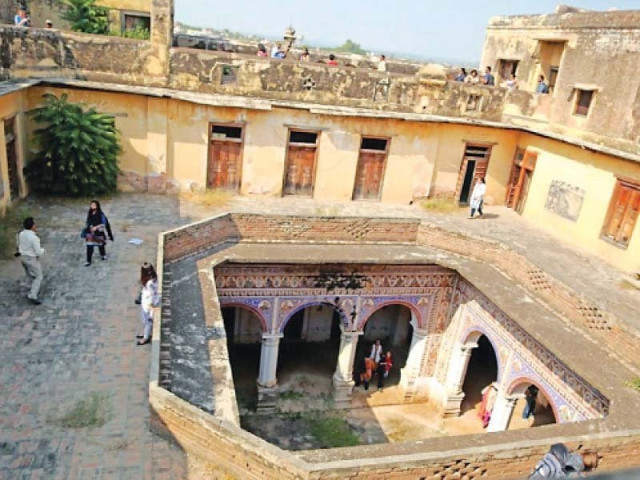
Pale yellow walls and centuries-old engraved wooden door welcome visitors inside the forgotten Khem Singh Haveli.
Located in Kallar Syedan, a sub-region of Rawalpindi, 30 kilometers off Rawat road, the haveli is commonly known as ‘Babay Da Mahal.’

Locals help you walk through narrow back alleys to the edge of the town where the haveli is located, while narrating stories connected to it.
The four-storeyed structure was constructed by Khem Singh Bedi, one of the founders of the Singh Sabha movement, in the late 19th century.
The red-bricked structure constitutes of 22 rooms and three basements embellished with brilliant frescos, paintings and carved woodwork. The focal-yard is supported by a system of corridors leading to galleries, wooden doors and stunning fireplaces, still intact. The ancient architecture also has some oriels on different sides of the focal-yard. A spiral staircase leads to rooftop where one gets a bird’s-eye view of the town.

The partition of open yard is creatively finished with a series of pictures including depictions of Sikh masters, warriors, Hindu goddesses and also some Muslim rulers. It is likewise trusted that a number of pictures speak of acclaimed Muslim warriors of subcontinent, which leads to believe that Baba Khem Singh, despite being a crucial member of the Sikh movement, was a secular man.
Quaid-i-Azam University Taxila Institute of Asian Civilisations Director Dr Ashraf Khan told The Express Tribune that “Khem Singh Haveli was constructed using the finest wood and carved with intricate designs by some of the celebrated masons and artists from Attock.” Despite being in a terrible condition, some of the artworks can still be seen in courtyard and other parts of the haveli, he added.
As indicated by research and references in Sikh history, Khem Singh helped the British Raj during the 1857 Indian rebellion in smothering defiance in Gugera, a town close to Okara. In acknowledgment of his work, he was designated as a judge in 1877 and was later assigned to the Viceroy’s Legislative Council in the late 1800s.

Adding to the subject, Amjad Minhas, author of the book ‘Potohar Nama’ said “Rawalpindi and Potohar regions have many archaeological assets that have been overlooked in terms of maintenance.” Unfortunately, most of these places have been abandoned, some encroached upon while a few damaged due to natural disasters, he expressed.

Other than being a brave warrior, Khem Singh is also widely known for his generous contributions in education and religious spheres of that time. The haveli was being utilised as a public school for boys after the partition till about a decade ago, but due to its dilapidated condition, the school had to be moved to another building close-by.
Published in The Express Tribune, September 28th, 2015.


















COMMENTS
Comments are moderated and generally will be posted if they are on-topic and not abusive.
For more information, please see our Comments FAQ